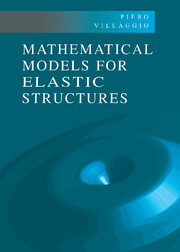Book contents
- Frontmatter
- Contents
- Preface
- Introduction
- Chapter I Basic Concepts
- Chapter II Rod Theories: Three-dimensional Approach
- Chapter III Rod Theories: Director Approach
- Chapter IV Theories of Cables
- Chapter V Theories of Membranes
- Chapter VI Theories of Plates
- Chapter VII Theories of Shells
- References
- Index of Authors Cited
- Index
Chapter VII - Theories of Shells
Published online by Cambridge University Press: 11 September 2009
- Frontmatter
- Contents
- Preface
- Introduction
- Chapter I Basic Concepts
- Chapter II Rod Theories: Three-dimensional Approach
- Chapter III Rod Theories: Director Approach
- Chapter IV Theories of Cables
- Chapter V Theories of Membranes
- Chapter VI Theories of Plates
- Chapter VII Theories of Shells
- References
- Index of Authors Cited
- Index
Summary
Geometric Definitions and Mechanical Assumptions
A curved plate or shell may be described by means of its middle surface, its edge line, and its thickness 2h. We shall take the thickness to be constant, and consider the two surfaces of constant normal distance h from the middle surface and placed on opposite sides of it. These two surfaces constitute the faces of the shell. Let s denote a closed curve drawn on the strained middle surface, and consider the outer normal v to this curve at a point P1? drawn in the tangent plane to the surface at P1 and let s be the unit vector tangent to s, directed counterclockwise. Then let n denote the unit normal to the middle surface at Pi oriented positively so that the triad (v,s,n) is righthanded (Love 1927, Art. 328). We consider a point P1 on the curve s, at a small distance 8s from Pl5 and take the two segments constituted by those parts of the normals to the middle surface at Px and P1 which are included between the faces of the shell. These two pieces of normal at Pi and P1 mark out an element of area δA (Figure 54.1) belonging to a developable surface the generators of which are perpendicular to the middle surface. The contact tractions exerted across the area δA are made statically equivalent to a force and to a couple applied at Pj. We define the averaged components of this force and couple per unit length of s by dividing their components by δs. The limits of these averages for δs → 0 are the stress-resultants and the stress couples transmitted across the curve s at P1. We assume that all these limits exist, and that the component of the stress couple along n vanishes. On taking a Cartesian system x', y’ z along v, s, n, with its origin at P1, the stress-resultants are denoted by T, S, and N, respectively, and the nonzero couple resultants by H and G. These stress- and couple-resultants may be written in terms of the stress components referred to the axes x', y’ and z.
- Type
- Chapter
- Information
- Mathematical Models for Elastic Structures , pp. 547 - 653Publisher: Cambridge University PressPrint publication year: 1997



